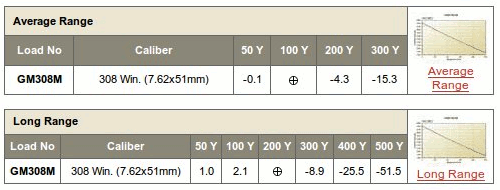Reading ballistic tables
Ballistics tables are available from all bullet manufacturers. Let's look at how to read and use this information.
The sample data I use is from this page: Federal Premium 308 Win. (7.62x51mm) Sierra® MatchKing BTHP
Velocity

This data shows the speed, in feet per second, the bullet has at different ranges. Some bullets keep their speed at longer ranges than others.
Bullet speed is vital to calculate bullet flight time when shooting at moving targets.
Energy

This data shows the energy the bullet has at different ranges. You can use this data to compare the energy transfered to the target by different bullets.
Compare the energy the above bullet has at 400 yards to the same value for the 300 Rem. Ultra Magnum Trophy Bonded® Tip.
The .308 has 1398 foot pounds compared to 2404 for the .300 RUM!
Wind drift

In previous pages, it was showed that wind affects bullets.
A 10 MPH cross wind will push the .308 BTHP bullet off it's flight path by 7.4 inches at 300 yards. Wind drift is proportionnal to wind speed. Therefore a 5 MPH wind pushes the bullet by half the values a 10 MPH wind does.
This data is vital when shooting in wind. This data should be printed and carried with you (along with range data below).
Range

The range tables inform you on the bullet flight path. The scope zero distance is indicated by the ⊕ symbol. Negative values indicate that the bullet will hit below the point of aim. Positive values, above the point of aim.
From the table above, you can see that:
- If your scope zero distance is 100 yards...
- And you aim at a target which is at 200 yards from you...
- The bullet will hit the target 4.3 inches below the point of aim.
- So if you want to hit bullseye, you have to aim 4.3 inches over your intended impact point. Or you can correct your scope elevation turret for the same amount.
Ballistic tables
Consider the following range table (fictionnal data, not for any cartridge):
| Distance (yards) | |||||||||
|---|---|---|---|---|---|---|---|---|---|
| 100 | 200 | 300 | 400 | 500 | 600 | 700 | 800 | 900 | 1000 |
| 2.2 | ⊕ | -9.2 | -26.5 | -53.3 | -91.5 | -143 | -210 | -295 | -400 |
Let's assume you zeroed your scope at 200 yards. From the table below, you now know that if you want to hit a target at 500 yards, you will have to aim 53.3 inches over the target.